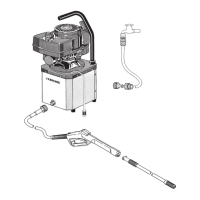6
KÄRCHER 1350 G
5. Operation
Ventilating the appliance
••
••
•
Open the water intake.
••
••
• Start the engine according to the operating
instructions of the engine manufacturer.
••
••
• Allow the appliance to run without the high-
pressure hose until the water emerges without
bubbles.
••
••
• Then connect the high-pressure hose.
Two-way nozzle
••
••
• It is possible to work with a high-pressure or a
low-pressure jet.
••
••
• Changing the jet form is only possible with the
hand gun closed.
– Release trigger.
– Turn changeover nozzle 90° to alter pressure
of the water jet.
High Pressure
Low Pressure
••
••
• The symbol of the chosen jet form is on the
upper side of the changeover nozzle.
Detergents can only be syphoned at low
pressure.
Pressure and flow regulation
••
••
• The water flow and pressure can be easily
adjusted by setting the engine control to “SLOW”
or “FAST”.
– Ensure that the appliance is situated on
firm ground.
– The water jet emerging from the high-
pressure nozzle causes the gun to recoil.
An angular spray lance will also cause
a torque. Therefore, grip the spray lance
and gun firmly.
– Never direct the water jet at people,
animals, the appliance or electrical
components.
– The high-pressure cleaner must not be
operated by children (danger of
accidents caused by improper use of
the appliance).
– Vehicle tyres/tyre valves may only be
cleaned at a minimum distance of
20 ft. Otherwise the vehicle tyres/tyre
valve may be damaged by the high-
pressure jet. The first indication of
damage is discolouration of the tyre.
Damaged vehicle tyres can be highly
dangerous.
– Materials containing asbestos and other
substances which are detrimental to
health must not be sprayed down.
– Suitable protective clothing should be
worn to protect the operator from back-
spray.
– Always ensure that all connecting hoses
are securely screwed on.
– The gun trigger must not be clamped
when operating the appliance.

